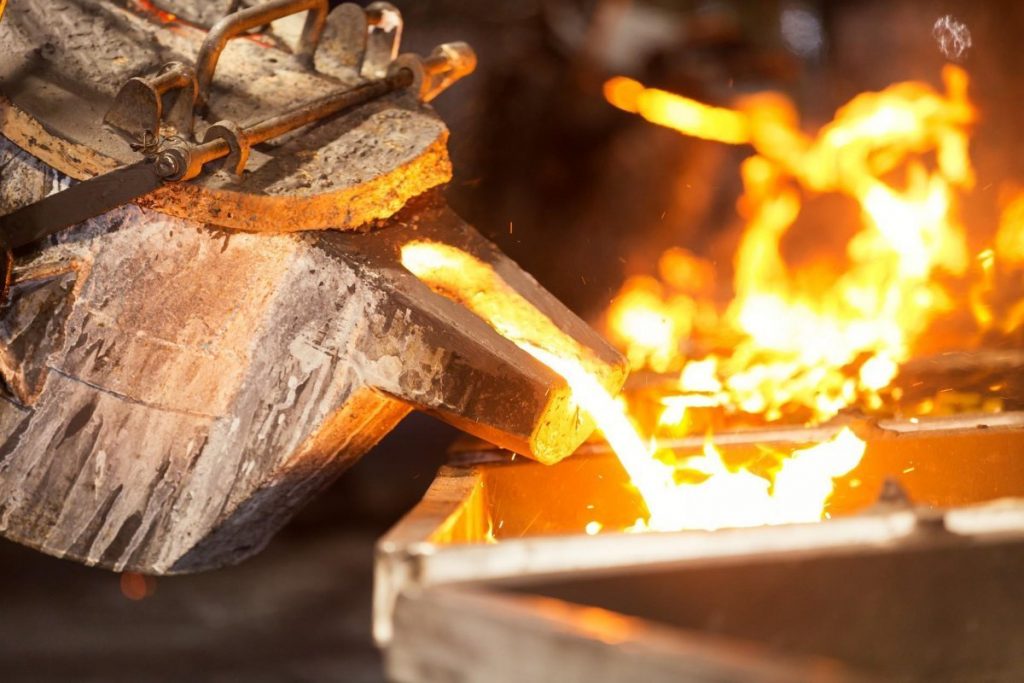Casting of steel and its alloys holds a prominence in the manufacturing world due to the fact that the parts produced from it find essential applications in sectors like automotive, aerospace, and industrial machinery. In the preparation of a steel casting, liquid steel is allowed to flow into molds. Hence, complicated shapes that can bear a high degree of stress and temperature can be manufactured. Thus, these castings are highly crucial for the durability and reliability expectations of whatever products they are integrated into.
During the last couple of years, India has emerged as one of the major players in the world steel castings market. Backward integration with state-of-the-art technology and an abundance of raw material, coupled with a growing manpower resource, promises to bridge both domestic and international demand. The following article narrates the latest trends, market insights, and challenges for steel castings exporters in India.
Growth of the Steel Casting Market in India
Several aspects have driven up the growth of the steel casting market in India. Hastening Industrialization, infrastructural development, and mounting automotive production in the country have been increasing demand for good-quality steel castings. The biggest sector, which is a heavy consumer of steel castings, ranges from critical components such as engine blocks and chassis parts to transmission systems.
Moreover, expansion in the aerospace industry, requiring lightweight but very strong parts, is taking place. All of these industries are continuously expanding and also striving for novelty and efficiency, which has caused the demand for advanced solutions in steel casting to increase.
- Key Market Dynamics
With factors such as global demand, technological advancement, and competitive pricing, India is an ideal market for exporters of steel castings. There are certain market dynamics which should be understood for the exporters to work effectively in the international market.
- Demand from Emerging Economies: Emerging economies in Asia, Africa, and South America also invest more heavily in infrastructure and manufacturing capabilities, which is driving demand for steel castings. Indian exporters are well-positioned to meet demand in these emerging markets as these regions begin to build an industrial base.
- Technological Advancements in Casting Processes: Steels castings have improved on the manufacturing technology front. The principal innovations such as 3D printing and automated casting methods are indeed altering production capacities. Those technologies will allow manufacturers to make more intricate geometries with higher precision, thus enhancing performance and trimmings of wastes. No doubt that they will empower Indian exporters to get a better hold in the global marketplace.
- Shift to Sustainable Practices: With increased consciousness about environmental protection, steel casting industries are widely adopting more environmentally friendly manufacturing practices. Several exporters these days are into incorporating eco-friendly processes-merging recycled materials and reduction of carbon emissions. This focus on sustainability not only appeals to environmentally aware consumers but also meets global regulatory trends.
- Challenges Faced by Exporters of Steel Castings
While there are some growth factors present in the Indian market for exporters of steel castings, there remain challenges to be overcome. Such challenges need to be understood by the exporters in order to formulate strategies for market complementarities.
- Price Volatility of Raw Material: Another significant challenge that exporters face involves the fluctuating prices of raw materials, which are among the most important- steel. Volatility in price can affect profitability and budgeting hence exporters should have strong supply chain management practices that reduce such an effect. This is through the development of long-term contracts with suppliers and other alternative source strategies.
- Competition Provided by International Players: Competition in the steel casting market is so high that majority global players are competing for the market share. Countries like China and Brazil have competitive pricing, making it disperse the competition in product offering and hence acting as deterrents for Indian exporters in those markets. Indian companies will have to focus on product quality, customer service, and innovation rather than challenge competitor strategies on pricing.
- Regulatory Compliance: Exporting steel castings thus faces a whole multitude of regulatory difficulties not only within India but in destination countries. Adherence to international standards, tariffs, and customs procedures is not only cumbersome but also tends to be very time-consuming. Exporters will have to invest in understanding the regulatory framework and seek the benefit of partnerships with logistics providers that specialize in international shipping.
Market Trends Affecting the Exporters of Steel Castings
It is a changing environment in which an exporter has to be knowledgeable about the main market trends shaping and reshaping the industry of steel casting exporters. This will provide him with certain insights into customers’ preferences or newly emerging opportunities.
- Growing Demand of Low-weight Components
Since the usage of lightweight material is an uprising phenomenon, especially in automobile and aeronautical industries, the manufacturers usually go for weight reduction of their components to achieve high-level fuel efficiency along with performances. It provides a scope for exporters of steel casting to innovate new technology and develop such material that will meet the demand for strength with lightness in today’s industry.
- Customization and Tailor-made Solutions
As such, industries grow and develop; hence, customized solutions develop for specific requirements. Exporters of steel castings are highly oriented toward the provision of products that are tailored to the specifications that clients come up with. This trend of offering tailored services increases the satisfaction of customers and helps exporters an edge over competitive companies.
- Digital Technologies Integration
In the industry of steel casting, IoT, data analytics, and other such digital technologies have been integrated into the processes of manufacture. This allows manufacturers to track production processes in real-time and hence make operations more optimized. In fact, even the quality control improves with these technologies. With the digital transformation, exporters will be more efficient and responsive to market demand.
- Expansion of E-Commerce Platforms
E-commerce is the future way of doing business in the steel casting industry. It creates opportunities for exporters to expand their horizons through online mediums and makes the process of buying much easier. Online investment, especially in digital marketing strategies, is going to be the main decisive factor that will give an edge to the exporter in the new dimension.
Quality Assurance: The Vital Role in Export of Steel Casting
For exporters of steel castings, quality assurance is the bedrock from which a good reputation on the international market base can be achieved. Stringent quality standards imply complete customer satisfaction and, in turn, the generation of trust and reliability.
- Implementing Quality Management Systems
Quality management systems should be instituted at the enterprise to monitor and control most aspects of the casting process. Compliance with such requirements for industry-recognized standards such as ISO 9001 will ensure better operational efficiency and commitment to quality. Auditing and regular inspection of the facilities are also needed to realize the deficiencies in improving on standards but will ensure compliance with recognized and set standards.
- Rigorous Testing
Testing is one of the most important procedures in quality assurance testing. Exporters of steel casting need to do intense testing regarding mechanical properties, durability, and performance under different conditions. Advanced testing techniques, such as non-destructive test techniques, enable the detection of defects early within specific cycles of the production process.
- Relationship Building with Clients
Laying the right relation with the client will definitely help in achieving more and more return business, as well as loyalty from them. The creation of confidence in buyers can be ensured through visible explanation of the quality assurance practices and testing results. Detailed documentation and certification will also go a long way in enhancing credibility and reinforce this commitment to quality.
Outlook for Exporters of Steel Castings from India
The various forcings that now shape the face of the industry would seem to indicate the enormously promising future for Indian exporters in the industry of steel castings. A comprehension of these factors would therefore enable exporters to prepare for the future both in terms of challenges and opportunities.
- Continued Investment in Infrastructure
The demand for steel casting is likely to grow with high investment in the development of infrastructure. Similarly, the “Make in India” initiative by the government would boost the manufacturing capabilities, and then the National Infrastructure Pipeline would provide the best environment for exporters. All these factors will then boost not only the local demand but also attract foreign investments.
- Emphasis on Research and Development
Exporters have to innovate their processes by investing in research and development, compete with other exporters of scraps, and retain top-notch talent. Casting of new materials and technologies might be facilitated through collaboration among academic institutions, research organizations, and industry partners. It can help exporters develop some value propositions that make sense to clients.
- Expanding Global Reach
It is the right time, as global markets are rapidly changing, for exporters from India to diversify into more recent and newer markets beyond traditionally known markets. Entry into emergent markets, especially from Africa and Southeast Asia, shall be identified and tapped for new business capture. Building good distribution networks with strategic partnerships with local players will improve market penetration.
- Focus on Sustainable Practices
More and more, sustainability has become a concern for both customers and companies. This means that steel casting exporters will have to consider environmental concerns in the entire value chain of production. These are things such as waste reduction, renewable sources of energy, and use of recycled materials. It is these that will increase corporate responsibility, perhaps bringing about customers who prefer greener alternatives.
Conclusion
The turps ace in terms of steel casting exporters in India is a blend of opportunities and challenges that lay ahead. Indian exporters shall remain updated with the emerging market dynamics to meet the ever-growing demand for quality and durable components across various sectors. The exporters can make a niche for themselves in the competitive world market by embracing advanced technologies, sustainability, and adhering to the highest standard of quality. There is a great future in steel casting with immense growth and innovation opportunities. The exporters of steel castings have recently come into play-to-play other critical roles in the supply chain for an even wider array of industries worldwide as India further works upon enlarging its manufacturing base and elbowing its way into more international markets. Indeed, with its rich resource base combined with a skilled manpower and burgeoning technological capabilities, India finds itself contradictorily placed in the global market for steel casting.
FAQs
- What is a steel casting?
Steel castings are components made by pouring molten steel into molds, which allow the making of complicated shapes so important for many different industrial uses.
- How significant are steel castings in the manufacturing process?
Steely castings boast of high strength and durability and hence are prolific for items in heavy application in all industries ranging from automotive and aeronautical to construction.
- What is the growth prospect of the market for steel castings in India?
The Indian steel casting market enters the path of growth demand and innovative operating practices, considering the changing patterns of industrialization and technology awareness with a strong focus on value addition and sustainability.
- What are the problems faced by exporters in the steel casting industry?
Exporters face difficulties related to fluctuating raw material prices, aggressive competition, and regulations as required, all of which led to a need for skilled labor.
- What is the position of quality assurance on export steel castings?
Quality assurance means many things to reliability and meeting international standards, building trust with the clients, and enhancement of market reputation for exporters.



